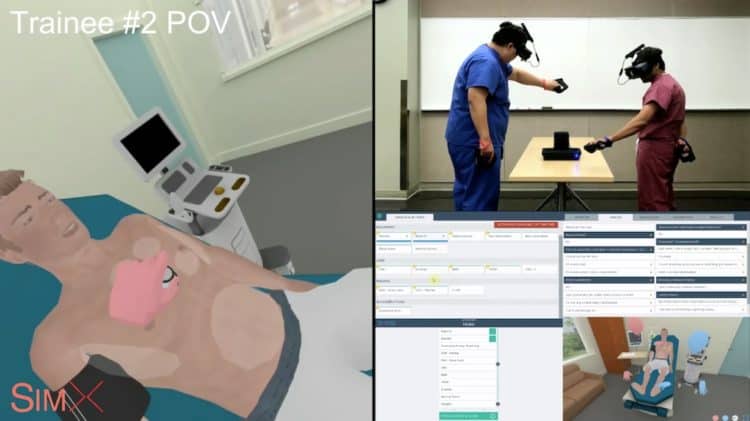
Virtual reality is a technology that has grown exponentially from where it (technically) first began in 1838 with the invention of stereoscopic photos and viewers like the stereoscope developed by Charles Wheatstone in 1838, the lenticular stereoscope developed in 1839 by David Brewster, and the View-Master developed by William Gruber in 1939. Fast-forward to 1960 when Morton Heilig invented and patented the “Telesphere Mask,” the first example of a head-mounted display (HMD). The Telesphere Mask did not include any form of motion tracking, nor was it interactive – it was meant as a film medium and provided stereoscopic 3D and wide vision with stereo sound. However, the next year, two Philco Corporation engineers would go on to develop the first motion tracking HMD in 1961 called the “Headsight.” Fast-forward again to 1991 where The Virtuality Group launches a range of virtual reality arcade games and machines with the goal to bring video games to a new level where players would play games in virtual reality with realtime (less than 50ms latency), some of these units were even connected together for a multiplayer experience. Taking a trip to 2012 now, Palmer Lucky launches a Kickstarter in an attempt to fund development for his prototype virtual reality headset known as….The Rift. Fast-forward once more to 2021 and virtual reality has now evolved far beyond the realm of gaming and entertainment with the ability to now provide full-functioning simulation technology to benefit nursing students in their education, providing them with an opportunity to experience certain situations that would be nearly impossible to replicate in a real-world scenario. One of the leading developers of this technology is SimX, dedicated to being the “first comprehensive professional-grade VR medical simulation system.”
What is SimX?
SimX is a virtual reality healthcare simulation that can be used wirelessly, includes full multiplayer functionality, and is the first (and currently only) cross-platform application of this technology, capable of being used on any compatible virtual reality headsets like Oculus and HTC Vive. SimX currently has more than 150 different patient models, 30+ different operating environments, and over 300 tools and procedures. According to the SimX website, “the SimX platform allows for the rapid creation of cases customized to your needs. From routine clinic visits to multi-trauma cases for field medics. From basic assessment for MA training to post-operative ICU cases for specialists. The SimX system can do it all. And because of our powerful engine and in house medical and technical teams, SimX builds these cases in a matter of weeks, and for a price 1/10th the cost of the competition.” SimX allows for instructors, learners, and observers to interact in any virtual scenario ranging from a foot injury and blood sugar diagnosis, to a house visit to a non-compliant patient’s residence. I actually got a chance to speak with the CEO of SimX, Ryan Ribeira, who was able to talk about the future of SimX and what exactly the technology has to offer.
How long has this SimX system been in development?
Ribeira: “Yeah, well, so you know we actually started developing it back in 2013, that’s when I was still in medical training. It grew out of my own experiences going through traditional simulation with, you know, mannequins and standardized patients and learning a lot from those experiences, but recognizing that there were some substantial limitations that virtual reality could address. So we started building in 2013, that’s when we filed for our initial patents, but the hardware at that time really wasn’t good enough to launch a commercial product, it was still pretty clunky – it was still really expensive, but the hardware – the VR and the AR hardware – kept getting better and better and then we launched the product [SimX] in 2018 and have grown a lot since then.”
Can you tell us a little bit more about the different patients and environments featured in SimX?
Ribeira: “Yeah, so, you know that’s kind of the beauty of virtual reality is your patient can be a grandmother, a baby, they can be vomiting, they can be missing limbs, and we have all of that and more. Really any demographic you can think of – we already have implemented in cases, in SimX. And then from an environment perspective, similarly, we have EDs [Emergency Departments] ORs [Operating Rooms], school clinics, we have med surg [medical-surgical] rooms, we have cases where you’re pulling someone away from a burning car and resuscitating them on the ground, cases where you are in a moving transport helicopter, cases where you’re on a base camp at Everest, so a very wide variety of environments. I’ll add that that’s really critical actually, in medical training, because whether you’re a nurse or a doctor, or an EMT, it’s not just about knowing the medicine and knowing what to do to treat your patient in that moment, it’s also being able to manage your environment – is the environment safe? Do you need to move yourself and the patient away? Are there family members that need explanations while you’re performing the treatments? There are other team members in the room that you need to manage, and that’s a big part about actually being a practicing clinician, and that’s something that we can replicate in virtual reality, but that’s very hard to replicate in traditional simulation.”
The last time we spoke, you had mentioned the initial development with a Meta AR headset. Does SimX currently have plans to develop its own first-party headset or are you thinking about just sticking with the software side of things?
Riberia: “Yeah, I think – you know – we are a software company first and foremost and nowadays, there’s a lot of great companies that are in the hardware space and making great advancements in the hardware every single year, so I think we are gonna leave the hardware to them and focus on making world-class medical simulation software.”
Over the last 5-10 years, virtual reality has evolved dramatically with the most popular use being for gaming and entertainment, now with this new SimX technology, do you see it evolving even more? Does SimX have plans to expand into other areas of virtual reality?
Ribeira: “Yeah, I mean I think virtual reality has the ability to make simulation suddenly accessible to a wide variety of fields, you know, and SimX’s underlying simulation engine is immediately applicable to fields outside of medicine. So we just got our first veterinary training contract and that’s a great field for virtual reality sim, because right now it’s very expensive, in veterinary training, to have simulators for every animal that you need to train your students on, but you can replicate that easily in VR. We have a chiropractic school that just signed up, we have firefighter training programs that we are gonna be on-boarding hopefully here soon, and that’s also a really great use-case, where right now, firefighters literally burn down buildings in order to simulate what it is like to go into their actual practice environments, but you can do that much easier in VR. So definitely, I think we plan to expand into areas outside of medicine and we see a lot of potential for virtual reality to help facilitate simulation training in a wide variety of industries.”
Have you yourself actually hopped in and tested out SimX and what do you think?
Ribeira: “Yeah, of course, in fact as we were in the final stages of preparing this curriculum with Elsevier, I was in the headset so often that I thought ‘I wonder if I should publish some kind of study on what happens when a human being spends more than 50% of their waking hours inside of a virtual reality headset.’ I definitely get plenty of opportunities to hop in, both in kind of testing the product myself and also as part of facilitating experiences for other people as we’re showing it to potential customers and partners and things like that. As far as what I think of it, I certainly wish I had training like this when I was going through medical school, again the mannequin sims and standardized patients are great experiences, but there’s just so much more that you can integrate into a virtual reality sim that is really hard to do on mannequins, and there’s a level of suspension of disbelief that you need to maintain in traditional sim that is not really quite as significant in virtual reality, and so I guess my takeaway when I made it, is that I’m a little jealous of the students that are gonna be training in this and the next generation.”
Given the involvement of SimX and Elsevier in this new technology, do you think that virtual reality is set up to become an even bigger support to our education system than it is now?
Ribeira: “Yeah, absolutely, and I think this goes hand in hand with some of what I was saying before, I think this is part of what is going to make simulation a bigger part of education going forward. I think the airline industry has recognized the importance of simulation and that’s why airline pilots have done hundreds – sometimes thousands – of hours of simulated flights before they ever step behind the controls of a commercial plane, and that is part of why flying in an airplane is safer than driving down the street, right? Because of that simulation training, and I think medicine has started to wake up to the importance of simulation, but we’re still not quite to that point. I foresee a future where similarly, doctors and nurses will spend as much time simulating rare cases as they will treating patients. That’s gonna be key, I think, to moving to the next phase in our pursuit of healthcare quality and safety and creating a very safe environment for our patients, but I think those same principals can extend to learning almost any skill; there’s a wide variety of industries that can benefit from simulation and the primary barrier has been the logistics. You can imagine if you were a mechanic training to be able to diagnose and treat the engine problems of any car in the world, you can’t really simulate that now – where are you gonna get all those engines? Where are you gonna get all those various ways that it can break down? With virtual reality, you can pop on a headset, have any engine in the world in front of you, and simulate any problem that you can encounter. I think that’s just another example of how virtual reality is gonna open up so many more doors to using simulation as a training modality across a wide variety of fields.”
Thanks so much, Ryan, for taking the time to speak with me (twice) about SimX and the evolution of virtual reality from gaming to the medical field! I actually got a chance to demo the technology in both of these scenarios. In the first scenario I got to experience, I was placed into a hospital room with a virtual patient and his wife, the moderator instructed me to measure his blood sugar using one of the hundreds of tools that SimX includes and I also had to monitor his oxygen. The second scenario I experienced was a home visit to a patient that was not complying and refused to utilize his oxygen tank; I had to give him his inhaler and practice several breathing techniques with him. I could interact with just about everything in the environment, however this definitely isn’t an “at-home” technology as you’ll need to clear about a 10 x 10 foot space to walk around the various environments in the simulation, since the movement method itself is not virtual, you’ll actually have to move around the environment yourself. This makes a lot of sense as virtual joystick movement wouldn’t actually prepare learners to move around an actual environment, and I’m sure that an institution that this technology is being used in will be much bigger than 10 x 10 feet. However, I did not have enough space to fully experience the whole thing.
Who is Elsevier?
According to the Elsevier website, “Elsevier helps research and healthcare professionals advance science and improve health outcomes for the benefit of society.” SimX has worked in tandem with Elsevier to develop and distribute this “Simulation Learning System” (SLS) with Virtual Reality technology. Recently, I got a chance to talk to the Director of Product Marketing at Elsevier, Danielle LeCompte, in order to discuss the SLS with VR technology and how it has evolved.
You’ve been a part of Elsevier for nearly 12 years in various roles starting as Marketing Coordinator in 2009 and now recently becoming the Director of Product Marketing in September.With your experience at the company, do you think that Elsevier has the potential to pioneer the nursing education industry?
LeCompte: “Indeed, yes. Yeah, absolutely, so Elsevier is really poised, we have a really rich history in being a market leader in content, that’s where we had our content business for hundreds of years and we really started out as more of a traditional publisher, right? So we have a lot of experience being world class education providers, and now we’re moving into more of our technology, right? In order to help our nursing and healthcare educational professionals become prepared for clinical practice, so we really have that background and that foundation in order for us to really be poised to move into more of these educational technologies that really compliment our content.”
I’ve owned a couple of virtual reality headsets in the past, but really I’ve only used it for gaming and entertainment, so at what point did Elsevier realize the potential for virtual reality to go beyond this medium of entertainment and gaming and move it into the medical industry?
LeCompte: “Excellent question, so we’re fortunate in the fact that we have a really excellent partner, SimX, they are the developers of this market-leading software that plays with the virtual reality content, and not only are they developing this technology, but they’re also medical doctors, so we have a lot of synergies in what our ultimate outcomes and objectives are for educating the future, either nurses or healthcare professionals, or medical doctors, right? So there are a lot of synergies in that sense. So simulation has always been a really core tenant of what we have been able to provide our nursing educational institutions across the spectrum, but we just found a great partner in SimX and really saw the potential for scalability and accessibility with the virtual reality technology; it provides that experience that our student nurses really need in order to really go into clinical practice with the experience that they need on day one, and that’s what virtual reality is really supplying us the opportunity in doing in collaboration with SimX.”
You mentioned that you have partnered with SimX developing this simulation learning system, but have you actually seen results that show this actually does improve a student’s ability to learn and retain information? What kind of results have you seen?
LeCompte: “Really good question, so preliminarily we have piloted this with half a dozen institutions in our test kitchens this past Fall. We just went GA [Generally Available] a couple of weeks ago, so this particular offering, we are going to continue to assess the efficacy of this particular offering, but simulation is rooted in much efficacy in the fact that we see the National Council of Student Boards and [Nursing], they did a study a couple of years back that suggested that when nursing institutions – they could actually replace up to 50% of their clinical hours that are required with simulation, and you would see the same, if not better, results as a result of using any sort of simulation whether that be virtual simulation in an avatar-based situation, or something like virtual reality for example. So the efficacious nature of simulation is very well rooted in research, but we’ll continue to work with our partner institutions in order to gain specific feedback in terms of the outcomes that we’re driving with this virtual reality product.”
Elsevier was founded in 1880, but the Elsevier family actually made its name in academia in the 1500s, other these 400+ years, it has evolved in such a way, how do you see it evolving in the future, do you think that Elsevier will continue to evolve with this virtual reality technology?
LeCompte: “Absolutely. So as I mentioned, we’re really rooted in academia, research, and science at the end of the day. So this lends itself for us to continue to make advancements with our partner institutions in order to provide them with technology like virtual reality in order to further their outcomes, because that’s really what we’re trying to do at the end of the day, is ensure that we are able to effectively prepare the next generation of student nurses, and we are very well-equipped – more so than anybody else in the market – Elsevier providing an end-to-end solution, and this being a very crucial piece of that – the simulation piece – as we know that clinical practice is obviously the end game for these nursing students, right? They have to have the experience in order for them to go into the clinical practice and with us partnering with SimX, this is actually providing the largest virtual reality collection on the market for healthcare, which is really exciting. So we are certainly poised, we have the right partners in place – in terms of SimX – in order to continue to deliver this best-in-class experience to drive positive outcomes at these nursing institutions.”
Thanks so much for taking the time to speak with me, Danielle.
Evolution in Virtual Reality
As you can see, both Elsevier and SimX have done their due diligence in order to come up with the best, most accessible, and most importantly the most affordable solution in order to further student education in the nursing industry. Virtual reality has evolved in countless ways over hundreds of years and it certainly shows no signs of slowing down anytime soon as we’ve seen with products such as SimX, it can be pushed even further than we previously thought possible. From non-interactive film viewing, to gaming, to nursing education, the future of virtual reality is just beginning to unfold in front of our eyes…literally. This is just the beginning and I think that virtual reality technology is far from reaching even half of its true potential with Gabe Newell, the head of Valve Corporation, claiming to be working on an even more sophisticated and advanced form of virtual reality gaming that would put the game inside the player’s head and would affect the user’s nerves, so that they could feel what is happening in the game. We have a long ways to go before we see virtual reality technology begin to slow and I, for one, am looking forward to seeing the next steps in the technology.
 Follow Us
Follow Us





